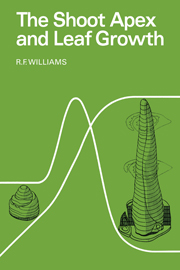8 - Plant growth as integration
Published online by Cambridge University Press: 04 August 2010
Summary
‘… a most influential part of the physiological environment of any single cell is provided by its neighbours … one cell's total environment thus differs to a greater or lesser degree from that of any other.
The march of relative growth rate does not therefore simply reflect changes in external factors, but is determined very largely by those internal processes of organization which set limits to the growth of practically all parts.’
richards (1969)This chapter attempts to draw the threads together, and will be rather more speculative in character than those that have gone before. Not only does the presentation of masses of descriptive matter require the cement of integrative speculation; the very emergence of a truly quantitative biology would seem to depend upon it. As pointed out in the introduction, it was found impractical to present the facts about growth and development of a range of shoot-apical systems (Chapter 4) without drawing attention to situations in which physical constraint seemed likely to be relevant to the interpretation of events. We can now take a closer look at those situations to see if they are consistent with the proposition that physical constraint is indeed a significant element in the genesis of form and the determination of rates of growth of various primordia. The proposition has already been developed by presenting the essential results of a study of the initiation and growth of tiller buds in wheat. This system is seen as a valuable test system for these ideas.
- Type
- Chapter
- Information
- Shoot Apex and Leaf Growth , pp. 207 - 222Publisher: Cambridge University PressPrint publication year: 1975

